Annotated Bibliography: Higher Education Research Analysis
VerifiedAdded on 2023/06/08
|5
|814
|369
Annotated Bibliography
AI Summary
This annotated bibliography presents an analysis of two research articles. The first article, by Bramhall et al. (2012), examines critical thinking skills in engineering master's students, highlighting their struggles in applying these skills in their studies and the impact of cultural differences. The authors recommend improvements in research methodologies. The second article, by EMİRa (2013), investigates the relationship between teachers' thinking styles and their critical thinking dispositions, emphasizing the importance of teachers' thought processes. The study utilized surveys and statistical analysis to find a significant correlation between teachers' thinking styles and their critical thinking abilities. Both articles provide valuable insights into the importance of critical thinking within the realm of higher education.
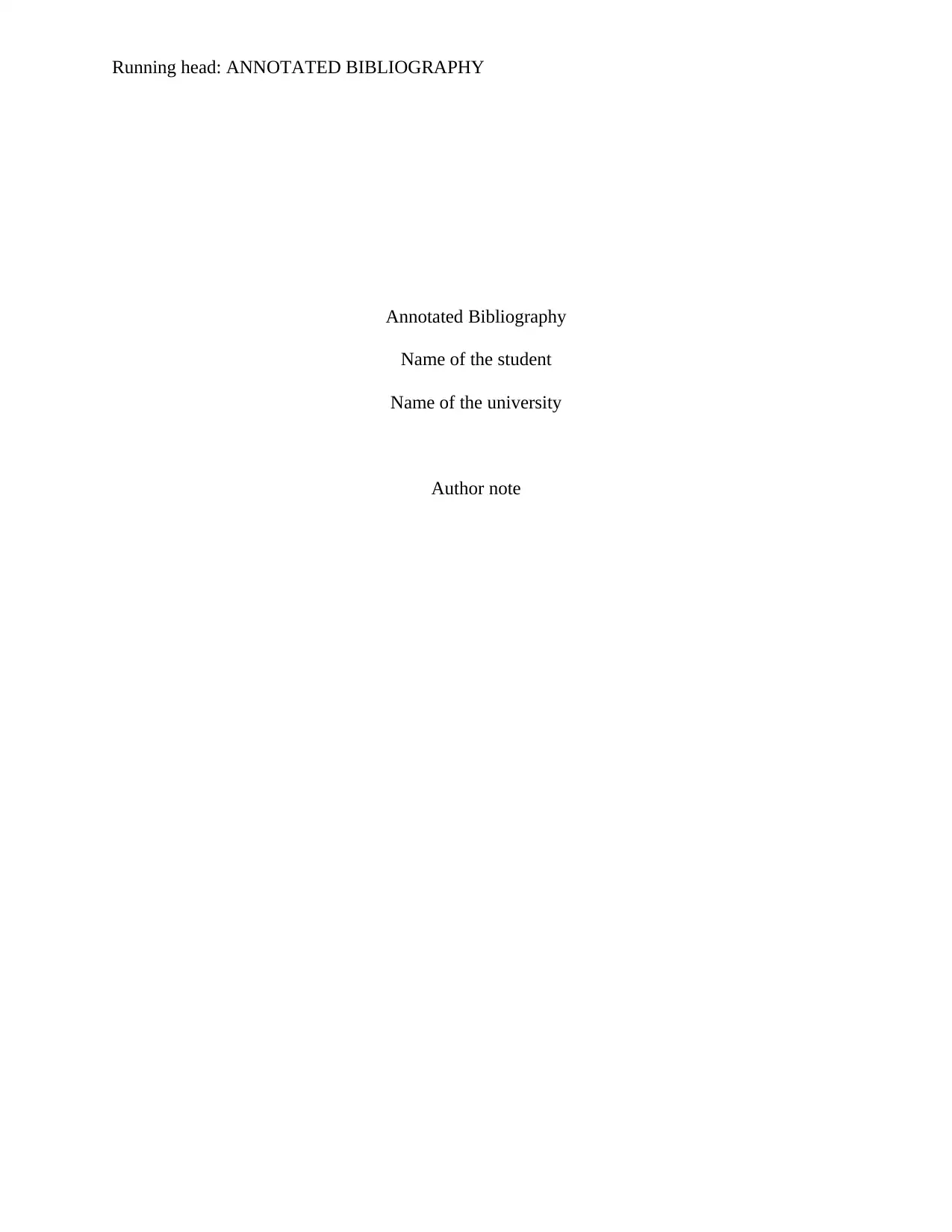
Running head: ANNOTATED BIBLIOGRAPHY
Annotated Bibliography
Name of the student
Name of the university
Author note
Annotated Bibliography
Name of the student
Name of the university
Author note
Paraphrase This Document
Need a fresh take? Get an instant paraphrase of this document with our AI Paraphraser
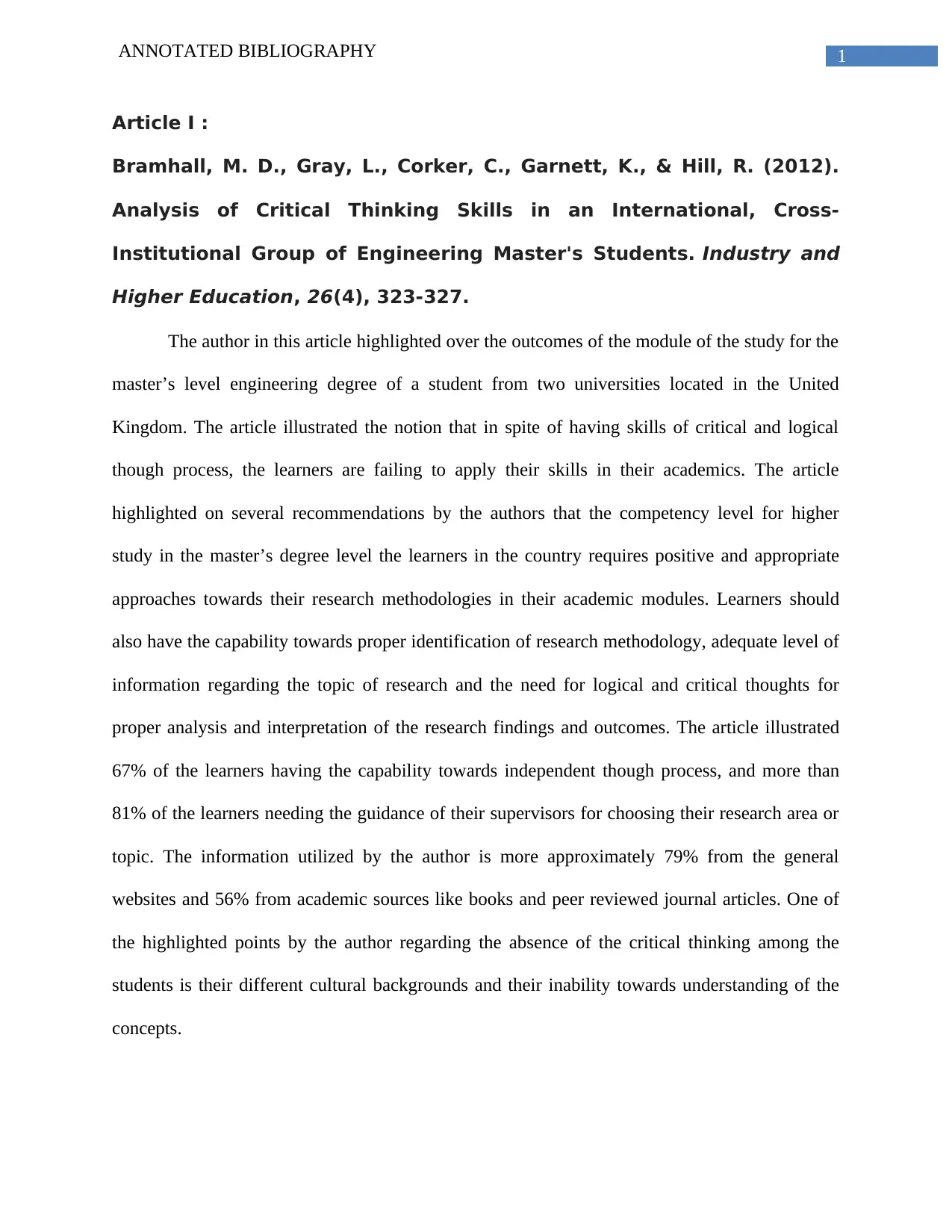
1ANNOTATED BIBLIOGRAPHY
Article I :
Bramhall, M. D., Gray, L., Corker, C., Garnett, K., & Hill, R. (2012).
Analysis of Critical Thinking Skills in an International, Cross-
Institutional Group of Engineering Master's Students. Industry and
Higher Education, 26(4), 323-327.
The author in this article highlighted over the outcomes of the module of the study for the
master’s level engineering degree of a student from two universities located in the United
Kingdom. The article illustrated the notion that in spite of having skills of critical and logical
though process, the learners are failing to apply their skills in their academics. The article
highlighted on several recommendations by the authors that the competency level for higher
study in the master’s degree level the learners in the country requires positive and appropriate
approaches towards their research methodologies in their academic modules. Learners should
also have the capability towards proper identification of research methodology, adequate level of
information regarding the topic of research and the need for logical and critical thoughts for
proper analysis and interpretation of the research findings and outcomes. The article illustrated
67% of the learners having the capability towards independent though process, and more than
81% of the learners needing the guidance of their supervisors for choosing their research area or
topic. The information utilized by the author is more approximately 79% from the general
websites and 56% from academic sources like books and peer reviewed journal articles. One of
the highlighted points by the author regarding the absence of the critical thinking among the
students is their different cultural backgrounds and their inability towards understanding of the
concepts.
Article I :
Bramhall, M. D., Gray, L., Corker, C., Garnett, K., & Hill, R. (2012).
Analysis of Critical Thinking Skills in an International, Cross-
Institutional Group of Engineering Master's Students. Industry and
Higher Education, 26(4), 323-327.
The author in this article highlighted over the outcomes of the module of the study for the
master’s level engineering degree of a student from two universities located in the United
Kingdom. The article illustrated the notion that in spite of having skills of critical and logical
though process, the learners are failing to apply their skills in their academics. The article
highlighted on several recommendations by the authors that the competency level for higher
study in the master’s degree level the learners in the country requires positive and appropriate
approaches towards their research methodologies in their academic modules. Learners should
also have the capability towards proper identification of research methodology, adequate level of
information regarding the topic of research and the need for logical and critical thoughts for
proper analysis and interpretation of the research findings and outcomes. The article illustrated
67% of the learners having the capability towards independent though process, and more than
81% of the learners needing the guidance of their supervisors for choosing their research area or
topic. The information utilized by the author is more approximately 79% from the general
websites and 56% from academic sources like books and peer reviewed journal articles. One of
the highlighted points by the author regarding the absence of the critical thinking among the
students is their different cultural backgrounds and their inability towards understanding of the
concepts.
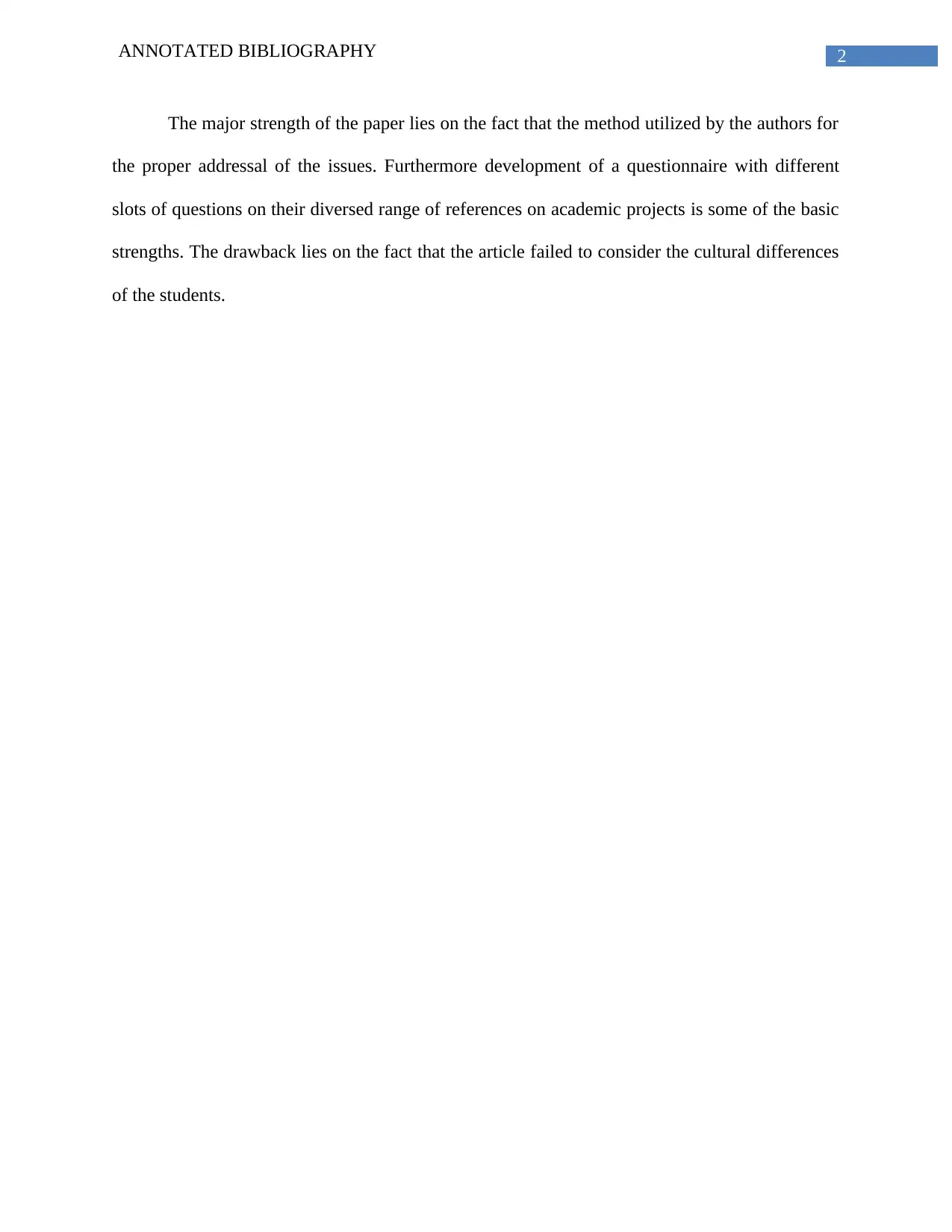
2ANNOTATED BIBLIOGRAPHY
The major strength of the paper lies on the fact that the method utilized by the authors for
the proper addressal of the issues. Furthermore development of a questionnaire with different
slots of questions on their diversed range of references on academic projects is some of the basic
strengths. The drawback lies on the fact that the article failed to consider the cultural differences
of the students.
The major strength of the paper lies on the fact that the method utilized by the authors for
the proper addressal of the issues. Furthermore development of a questionnaire with different
slots of questions on their diversed range of references on academic projects is some of the basic
strengths. The drawback lies on the fact that the article failed to consider the cultural differences
of the students.
⊘ This is a preview!⊘
Do you want full access?
Subscribe today to unlock all pages.

Trusted by 1+ million students worldwide
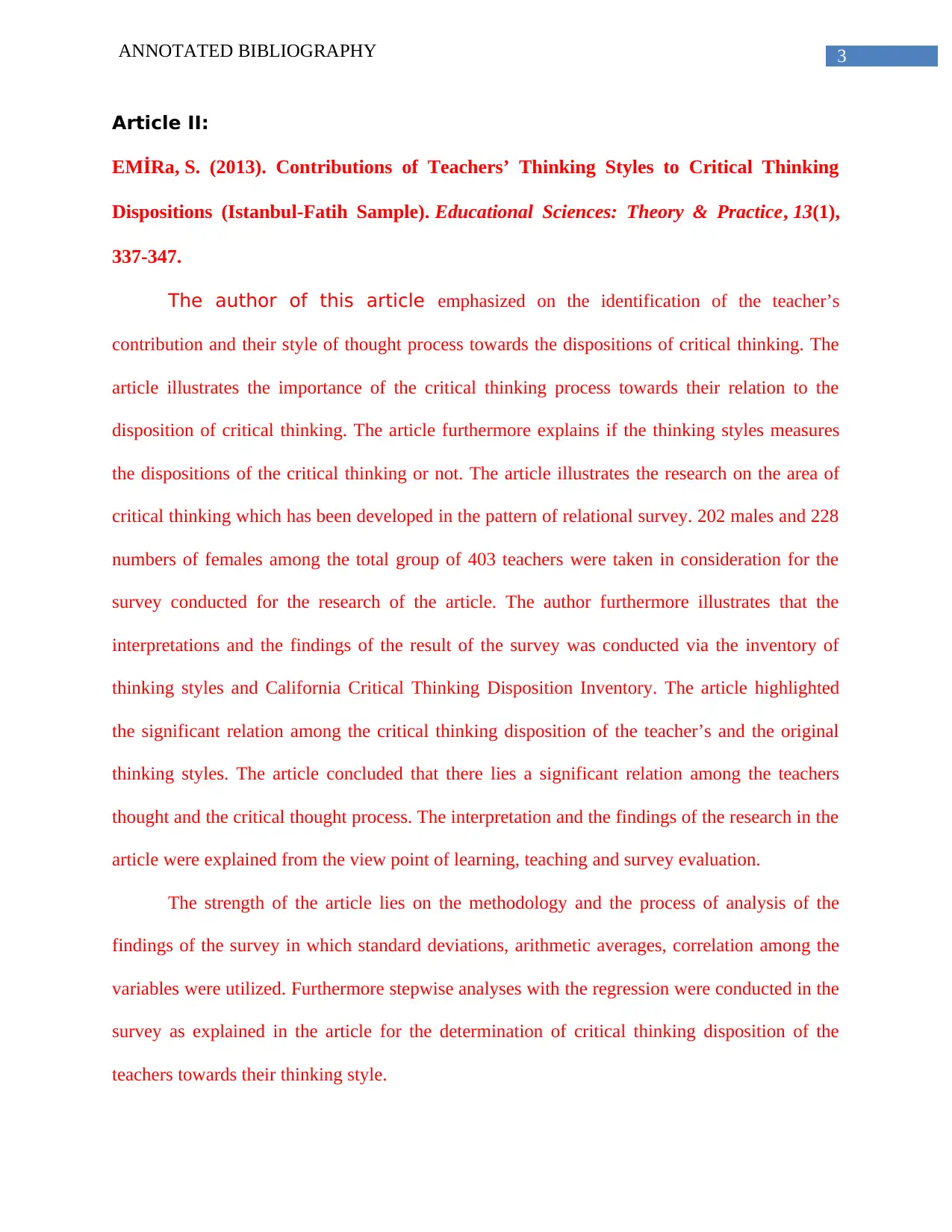
3ANNOTATED BIBLIOGRAPHY
Article II:
EMİRa, S. (2013). Contributions of Teachers’ Thinking Styles to Critical Thinking
Dispositions (Istanbul-Fatih Sample). Educational Sciences: Theory & Practice, 13(1),
337-347.
The author of this article emphasized on the identification of the teacher’s
contribution and their style of thought process towards the dispositions of critical thinking. The
article illustrates the importance of the critical thinking process towards their relation to the
disposition of critical thinking. The article furthermore explains if the thinking styles measures
the dispositions of the critical thinking or not. The article illustrates the research on the area of
critical thinking which has been developed in the pattern of relational survey. 202 males and 228
numbers of females among the total group of 403 teachers were taken in consideration for the
survey conducted for the research of the article. The author furthermore illustrates that the
interpretations and the findings of the result of the survey was conducted via the inventory of
thinking styles and California Critical Thinking Disposition Inventory. The article highlighted
the significant relation among the critical thinking disposition of the teacher’s and the original
thinking styles. The article concluded that there lies a significant relation among the teachers
thought and the critical thought process. The interpretation and the findings of the research in the
article were explained from the view point of learning, teaching and survey evaluation.
The strength of the article lies on the methodology and the process of analysis of the
findings of the survey in which standard deviations, arithmetic averages, correlation among the
variables were utilized. Furthermore stepwise analyses with the regression were conducted in the
survey as explained in the article for the determination of critical thinking disposition of the
teachers towards their thinking style.
Article II:
EMİRa, S. (2013). Contributions of Teachers’ Thinking Styles to Critical Thinking
Dispositions (Istanbul-Fatih Sample). Educational Sciences: Theory & Practice, 13(1),
337-347.
The author of this article emphasized on the identification of the teacher’s
contribution and their style of thought process towards the dispositions of critical thinking. The
article illustrates the importance of the critical thinking process towards their relation to the
disposition of critical thinking. The article furthermore explains if the thinking styles measures
the dispositions of the critical thinking or not. The article illustrates the research on the area of
critical thinking which has been developed in the pattern of relational survey. 202 males and 228
numbers of females among the total group of 403 teachers were taken in consideration for the
survey conducted for the research of the article. The author furthermore illustrates that the
interpretations and the findings of the result of the survey was conducted via the inventory of
thinking styles and California Critical Thinking Disposition Inventory. The article highlighted
the significant relation among the critical thinking disposition of the teacher’s and the original
thinking styles. The article concluded that there lies a significant relation among the teachers
thought and the critical thought process. The interpretation and the findings of the research in the
article were explained from the view point of learning, teaching and survey evaluation.
The strength of the article lies on the methodology and the process of analysis of the
findings of the survey in which standard deviations, arithmetic averages, correlation among the
variables were utilized. Furthermore stepwise analyses with the regression were conducted in the
survey as explained in the article for the determination of critical thinking disposition of the
teachers towards their thinking style.
Paraphrase This Document
Need a fresh take? Get an instant paraphrase of this document with our AI Paraphraser
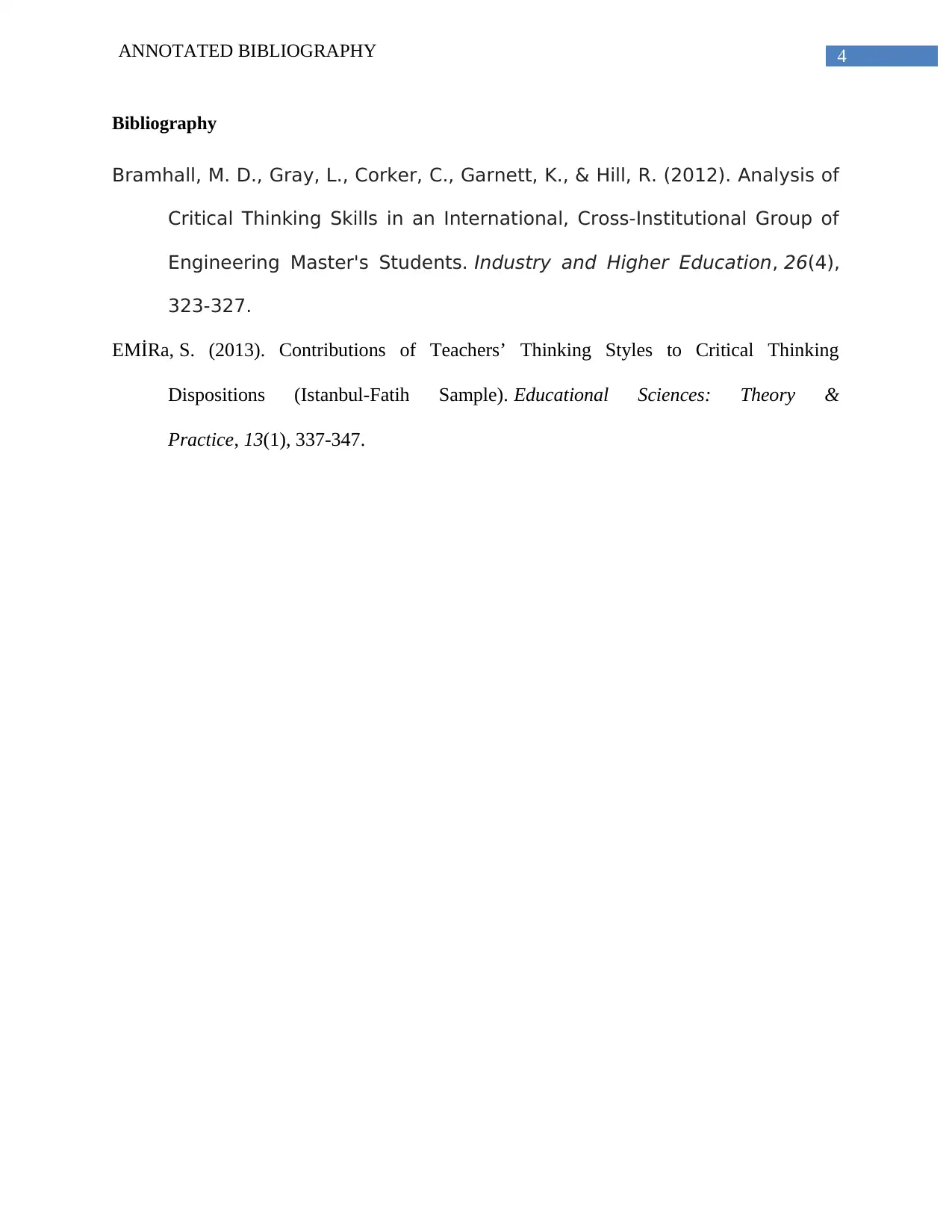
4ANNOTATED BIBLIOGRAPHY
Bibliography
Bramhall, M. D., Gray, L., Corker, C., Garnett, K., & Hill, R. (2012). Analysis of
Critical Thinking Skills in an International, Cross-Institutional Group of
Engineering Master's Students. Industry and Higher Education, 26(4),
323-327.
EMİRa, S. (2013). Contributions of Teachers’ Thinking Styles to Critical Thinking
Dispositions (Istanbul-Fatih Sample). Educational Sciences: Theory &
Practice, 13(1), 337-347.
Bibliography
Bramhall, M. D., Gray, L., Corker, C., Garnett, K., & Hill, R. (2012). Analysis of
Critical Thinking Skills in an International, Cross-Institutional Group of
Engineering Master's Students. Industry and Higher Education, 26(4),
323-327.
EMİRa, S. (2013). Contributions of Teachers’ Thinking Styles to Critical Thinking
Dispositions (Istanbul-Fatih Sample). Educational Sciences: Theory &
Practice, 13(1), 337-347.
1 out of 5
Related Documents
Your All-in-One AI-Powered Toolkit for Academic Success.
+13062052269
info@desklib.com
Available 24*7 on WhatsApp / Email
![[object Object]](/_next/static/media/star-bottom.7253800d.svg)
Unlock your academic potential
Copyright © 2020–2025 A2Z Services. All Rights Reserved. Developed and managed by ZUCOL.





